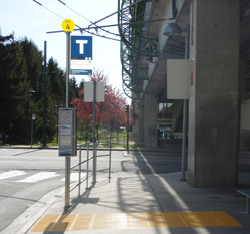Accessible transit pilot at Joyce-Collingwood Bus Exchange
Accessible transit pilot at Joyce-Collingwood Bus Exchange

Last year, when I traveled the system with Richard Marion, a visually-impaired man and member of the Access Transit User Advisory Committee, and created a podcast of the experience, I discovered that it takes a lot of effort to get to your destination if you’re unable to see where you are going. In TransLink’s efforts in making the system more accessible, we are rolling out a universally accessible pilot project at Joyce-Collingwood Bus Exchange aimed at improving the wayfinding of the bus system for those who are visually impaired.
If you’ve visited Joyce-Collingwood Bus Exchange since June of this year, you’d have noticed something a little different:
UPDATE: All of the bus stops at Joyce Bus Loop now have tactile strips!

The newly added bright, yellow, tactile strips to Bay three. The colour of the tactile strips helps people who have some sight, and the raised bars point towards the location of the bus stop pole, which helps both people with limited sight or none at all. People are able to feel the tactile strips with their feet or canes.
This portion of the pilot project was started last year in consultation with the a number of user groups including the Access Transit Users’ Advisory Committee, CNIB, formerly known as the Canadian National Institute for the Blind, as well as CMBC (Coast Mountain Bus Company).
Now that the tactile strips have been in place for several months and the feedback on them has been generally positive, it’s been decided that Bays 1, 2, 4 and the Handy Dart bus stop at the Bus Exchange will also be retrofitted with these additions.

Along with the addition of the tactile strips, Bay 4 at Joyce-Collingwood Bus Exchange will include a new bench and wayfinding signage similar to the wayfinding signage that can been seen at some stops on the Canada Line. In addition, the bus stop pole will also have a tactile information panel which will be on one side of the information cube (which also includes a walking map, SkyTrain map, and transit schedule information). The tactile information panel will have raised text and braille with information about the Joyce-Collingwood Bus Exchange, bus schedules and contact information.
Once everything has been installed, TransLink will be in touch with the users groups and CMBC to gather feedback.
This project is a pilot only and contributes to the finalization of TransLink’s draft universally Accessible Bus Stop Design Guidelines. We’ll look at the results of the pilot and consider how to move forward considering many factors including funding.
So, what do you think? Are you visually-impaired and have used any of these new accessibility features at Joyce-Collingwood Bus Exchange? If so, please take this poll. Since much of the pilot doesn’t start until November, the poll will be open until the middle of December. Of course, anyone can leave a comment about their experience with this pilot and how it could be improved by leaving a comment.
|
Do these accessibility additions at Joyce-Collingwood Bus Exchange help you with your commute?
Total Voters: 33 |






I have noticed in june when they first put them in. Wasnt anything too appealing to me. I thought it was for wheelchair users to get a better grip when coming on or off the bus. But i would mind seeing them pop up on all bays. They look interesting.
I think it’s a good thing. I hadn’t really thought about how much the world is switching to visual cues only – that was before I met a blind friend online. He can’t use anything with a touch screen, which they’re putting in practically everything nowadays.
That yellow (like the edging on Skytrain platforms) is bright enough for many people with vision problems to see, and has a pattern that blind people can feel. Much better than always having to depend on a sighted person to get anything done.
It’s like the stop announcements on buses. Each stop is verbally announced (good for the blind and anyone who doesn’t know the route very well) as well as written on a sign in the bus (good for the deaf and anyone with headphones permanently glued on).
Of course the question of the moment is who is going to pay for this? It’s not like there haven’t been any budget discussions recently…